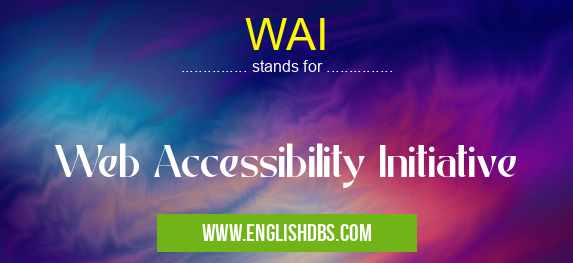What does WAI mean in COMPUTING
WAI or Web Accessibility Initiative is an international collaborative program launched by the World Wide Web Consortium (W3C) in 1997 with the goal of making internet and web content accessible to people with disabilities. Generally, it focuses on providing access to technologies that have traditionally been inaccessible to people with disabilities such as blind people, deaf people, those who cannot hear or speak, people with physical or motor disabilities, and those with cognitive impairments. The WAI promotes standards that make sure all members of society have equal access and opportunity to take part in activities online.

WAI meaning in Computing in Computing
WAI mostly used in an acronym Computing in Category Computing that means Web Accessibility Initiative
Shorthand: WAI,
Full Form: Web Accessibility Initiative
For more information of "Web Accessibility Initiative", see the section below.
What Does WAI Stand For?
WAI stands for the Web Accessibility Initiative. This international initiative originated from the World Wide Web Consortium (W3C), which is an international community dedicated to developing universally accepted standards for web-based systems worldwide.
The Objectives of WAI
The main objective of WAI project is to develop guidelines for creating accessible website designs for usergroups including visually impaired persons, persons having hearing problems and other users having physical disabilities. To achieve this goal, W3C developed a set of standards called Web Content Accessibility Guidelines (WCAG). WCAG includes requirements on how browsers can interact with assistive technologies in order to provide better accessibility. It requires sites to be designed in a manner that makes it possible for users with various forms of disabilities to gain full access and use of the websites information content and functionality as well as site navigation.
Essential Questions and Answers on Web Accessibility Initiative in "COMPUTING»COMPUTING"
What is Web Accessibility?
Web accessibility is the practice of making websites, web applications, and other digital products available to all users, regardless of any physical impairment or disability. This includes people with visual, auditory, motor, and cognitive disabilities. By following web accessibility guidelines and developing websites that are accessible to all users, you can ensure everyone has equal access to your online content.
Why is Web Accessibility important?
Web accessibility is important because it ensures that everyone has access to the same information and resources regardless of any need for assistive technology or lack of ability to interact with a website through standard inputs such as a mouse and keyboard. By upholding web accessibility standards you create a more inclusive online environment by allowing users with disabilities use your product just like everyone else.
What are WCAG standards?
The Web Content Accessibility Guidelines (WCAG) are part of a series of technical guidelines developed by the World Wide Web Consortium (W3C) concerning the technical aspects of building an inclusive web experience for disabled users. These guidelines provide criteria for developers when creating websites in order to make them more user-friendly for those living with disabilities.
How does Web Accessibility help people with disabilities?
By ensuring that web pages are designed according to accessibility standards, those with disabilities are able to access online information they may have otherwise been unable to access without the use of assistive technology or other adapted methods. This helps those with physical impairments or cognitive differences stay informed on matters related to their daily lives.
How do I make my website accessible?
There are several steps you can take when designing an accessible website including following the WCAG 2.0 standard, providing text alternatives for media content such as images and videos, utilizing semantic HTML elements, using descriptive page titles and headings, creating flexible layouts which resize according to device size and so on. Additionally you can also test your website’s accessibility using automated tools such as WAVE from WebAim.
What does 'Semantic HTML' mean?
Semantic HTML is a type of coding language used in web development which involves assigning specific meanings (or semantics) to different elements within a document structure in order for search engines or screen readers etc., understand what each element means. For example headings are marked up as h1 tags instead of just styling text bold etc., so that meaning is clear even if style definitions were removed from the page.
What is WAVE from Web Aim?
WAVE from Web Aim (Web Accessibility Evaluation Tool) is a free automated tool designed by experts which allows you scan pages on your website or App quickly for potential issue regarding overall accessibility according certain international standards such as WCAG 2.0 AA compliance.
How do I properly label images in my website?
Images should be labeled correctly using alternative text (alt-text), which should concisely give meaningful information about what’s contained within the image in terms of its context and purpose on the site itself i.e., alt-text describes what’s visible but cannot include personal opinion or unimportant details.
What kind of multimedia files should I provide along side articles on my blog/website?
In addition to providing audio transcripts along side audio files such as podcasts etc., it’s good practice also provide video transcripts along side video content ,as this provides subtitles so those who cannot hear can still understand what’s being said in videos.
Final Words:
The WAI has made great strides since its inception in 1997 towards ensuring websites are accessible to all users regardless of their level of accessibility needs. Through its development of standards such as WCAG, W3C continues to push boundaries so that everyone has equal opportunities when using the internet and websites no matter their limitations or abilities. By continuing this work into 2020 we can continue on the path towards digital inclusion ensuring every person can digitally interact effortlessly without any barriers whatsoever regardless of their age gender disability language or other characteristics they may possess.
